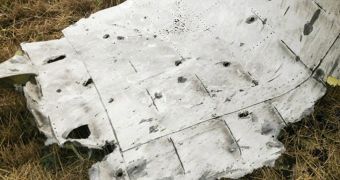On July 17, Malaysia Airlines flight MH17 crash landed in Ukraine, fairly close to the country's border with Russia. A total of 298 people died in this incident, and authorities are still trying to make heads or tail of what happened to the plane.
Recent news on the topic says that, shortly after several photos showing bits and pieces of the plane hit the public eye, an expert stepped forward and announced to the world that, according to evidence at hand, the aircraft was indeed hit by a missile.
The evidence that specialist and defense consultancy firm IHS Jane employee Reed Foster has in mind is small holes that are visible in the debris that was left behind when flight MH17 hit the ground and broke apart, Live Science informs.
Reed Foster maintains that, in order for the plane fragments to sport these small holes, some of which are visible in the image above, the aircraft must have had a very close encounter with high-velocity shrapnel originating from a missile.
The expert goes on to argue that, based on damage caused to the plane's body, chances are that the missile that took down flight MH17 was a Soviet-era supersonic one identified as SA-11. Still, it need be stressed that this theory has not yet been confirmed.
Reed Foster says that, unlike other weapons, such missiles are designed in such ways that they explode some time before actually making contact with their target. This means that the target is actually destroyed by the resulting shrapnel and the force of the blast.
The specialist goes on to detail that, according to information shared with the public, SA-11 missiles rely on an onboard radar system to figure out when best to explode in order to cause as much damage to their intended target as possible.
When finally blowing up, an SA-11 missile, whose speed is about three times greater than that of sound, coughs out high-velocity shrapnel, which travels through the air and rips apart whatever it encounters. In the case of planes, it causes engine failure and births tears in the aircraft's body.
Since the folks officially in charge of looking into this incident have not yet released detailed information concerning flight MH17's crash in Ukraine, it is unclear whether or not an SA-11 missile is to blame. Interestingly enough, word has it that pro-Russian rebels have used such weapons before.
Despite the fact that the plane crashed several days ago, media reports say that the remains of nearly 100 people are yet to be found. However, officials present at the site of the crash reassure that efforts will be made to recover whatever is left of the 298 people who died in this incident.

 14 DAY TRIAL //
14 DAY TRIAL //